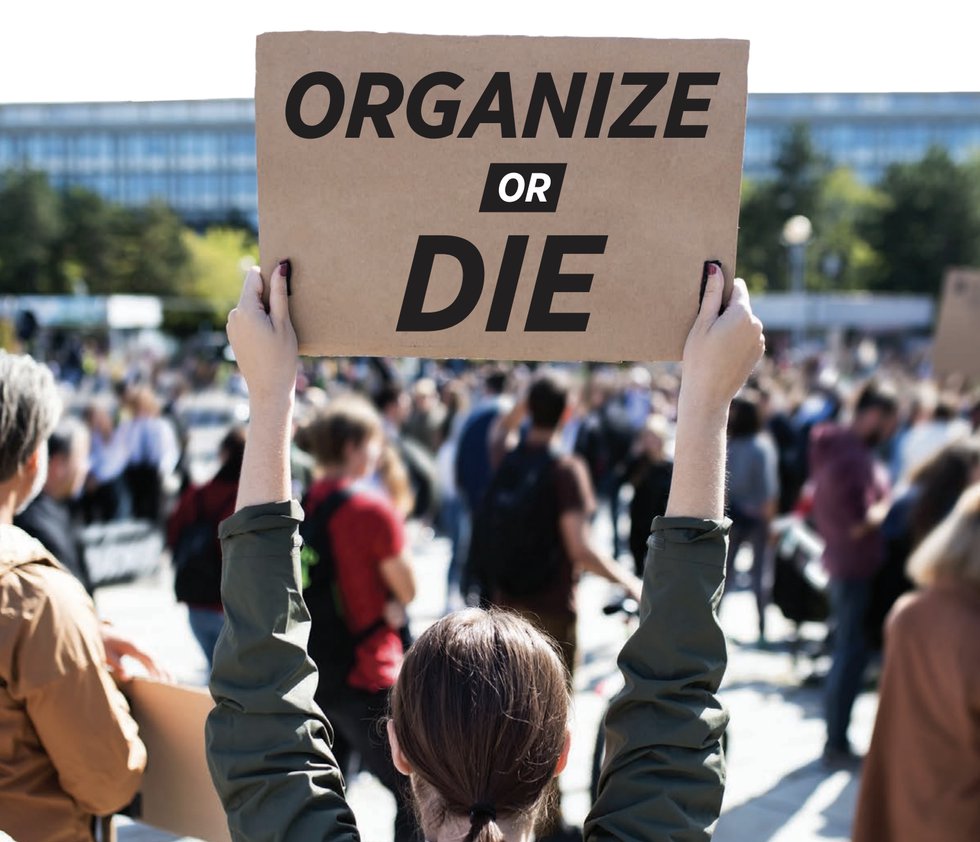Hamilton Nolan writes that unions must use the current momentum to drive new organizing.
According to Hamilton Nolan, unions must use their existing momentum to advance new organizing. According to Hamilton Nolan, unions must use their existing momentum to advance new organizing.
Hamilton Nolan writes that unions must use the current momentum to drive new organizing.
The nature of movements is that they keep moving forever (or until their goals are achieved, which often means forever). They can’t be understood until we pull back far enough to see all of their discrete events melting into the flowing river of the movement as a whole.. . The labor movement has given the impression in recent years of being in a drastic upsurge, characterized by a nationwide explosion of high-profile strikes and organizing campaigns. When we pull back, though, it becomes clear that organized labor is still in a deep, dark hole from which it has barely begun to dig itself out. The current moment of energy we are all celebrating is, at best, only a foundation for something much larger. It is what happens—or does not happen—next that will determine whether all of this excitement was justified.. . There is no doubt that the pandemic created fertile ground for unions. The general public—that vast and usually uninterested sea of people whose support is necessary for transforming unions from a niche into a mass movement—is paying more attention to the possibilities of organized labor than it has in generations. This is an unsurprising consequence of being dragged through a public health crisis, an unemployment crisis, and a government-fueled economic boom in a few short years.. . In 2020, millions of Americans found themselves unceremoniously laid off with no real safety net; millions of others found themselves called upon to continue working because they were deemed essential, only to find out later that they were risking their lives for little permanent reward. On both sides of the crisis, workers who may have never thought about labor power at all were rudely introduced to the harsh reality of what happens in its absence.. . COVID-19 and its aftermath were mass radicalizing events, the sort that can only arise from shared material crises. The arbitrariness of who did or did not suffer highlighted long-standing inequalities. White-collar workers kept right on working at home as the people who normally drove them to work, made their food, cleaned their offices, served them drinks, and entertained them at night found themselves jobless. Delivery drivers, grocery store workers, nurses, and millions of others ran themselves ragged to keep society afloat, only to see the public cheering and the “hero pay” bonuses fade away over time. No one who lived and worked through the pandemic needed to read Marxist books to come to a few inescapable conclusions: Workers are disposable. Your job doesn’t care about you. If you want any protections at all, you better organize and make them happen.. . For everyone who has grown up in the post-Reagan era, the palpable sense that unions have emerged from their decades-long defensive crouch is very real.. . Across the country, little eruptions of labor action showed that workers were taking these lessons to heart. In 2021, a mini-wave of strikes dubbed “Striketober” swept up industrial workers at John Deere, Nabisco, and Frito-Lay, and then the unionized student workers at Columbia University. That was followed by the successful union drives at an Amazon warehouse in Staten Island and at Starbucks stores, beginning in Buffalo, New York, and spreading and across the country. Those two campaigns inspired many more over the next year: Trader Joe’s! REI! Bookstores! Retail chains! Coffee shops! Fed up health care workers walked out. Tens of thousands of academic employees at the University of California struck. Only the of the intervention White House prevented a nationwide railroad strike. Stuff was happening.. . The intensity seemed to continue swelling this year. Twin strikes from the screenwriters of the Writers Guild of America (WGA) and the actors of the Screen Actors Guild and American Federation of Television and Radio Artists (SAG-AFTRA) shut down Hollywood altogether. The Teamsters extracted a rich contract for 340,000 United Parcel Service workers with a credible strike threat, and the United Auto Workers (UAW) staggered the Big Three automakers with a brilliant and unpredictable series of rolling strikes. By the end of the year, some estimates show the United States could have more workers on strike than it has had at any time in the past four decades. For everyone who has grown up in the post-Reagan era, the palpable sense that unions have emerged from their decades-long defensive crouch is very real.. . . All of these feats are reasons to celebrate. Now let’s add some reasons to have fear. Most of this period of resurgence has happened during the Biden Administration—the most pro-union presidential administration in more than half a century. Though Biden has not been an ally of labor to the extent that someone like Bernie Sanders is—he did crush the railroad strike, after all—he has publicly aligned himself with unions in a way that none of his predecessors have in recent memory.. . Besides lending the bully pulpit to labor’s cause, Biden’s National Labor Relations Board has pushed extremely hard to reform labor regulations in favor of workers and has pursued with uncommon vigor companies like Starbucks for illegal union-busting. All of that could change in 2024. If a Republican moves back into the White House, the federal government will become an anti-union entity overnight. The regulatory tailwinds will turn into a head-on gale.. . Likewise, the tight labor market that has served as leverage for workers in the wake of the pandemic won’t last forever. Existing unions that can negotiate contracts now may be able to lock in gains permanently. But for the rest of the labor force, the good times will, inevitably, be fleeting. In 2022, barely 10 percent of workers in the United States—and a measly 6 percent in the private sector—are union members. That means that nine out of ten working people have no access to collective bargaining and no mechanism to ensure that whatever moment of strength they currently enjoy does not just evaporate with the next macroeconomic fluctuation.. . ×. Expand. After some years have passed, we will either look back on this moment as the beginning of something big, or just one more upward blip on a long, downward trajectory for America’s unions. Which of these two scenarios plays out is within the control of the labor movement itself. Labor leaders have spent decades talking about what they would do if only the political or economic climate were better, or if public sentiment were in their favor.. . Well, the good times are here; it is time to act.. . The next presidential election is not the most important key to this. Nor is the state of the economy. What unions have entirely within their own control is organizing new union members. That is what must be done. Not thousands, or even tens of thousands, of new union members are needed, but rather millions.. . In 2022, 16 million Americans were represented by unions. If organized labor can’t get that number to increase significantly during this historically favorable period, then they aren’t serious about the idea of expanding worker power.. . It’s time for the labor movement to face the cold, hard fact that it has been failing to grapple with for a long time: Acquiesce to tiny declines in union density long enough, and you’ll end up in single digits—the last stop before true irrelevance. That is where we are today.. . It seems odd to say it, but all of the fabulous things that unions are winning today—industry-wide strikes, transformative new contracts, a welcome reception at the White House—will be meaningful in the long run only if we use them to propel new organizing. Otherwise, we’re just having a party on a shrinking island that will soon be flooded by encroaching waves of capital. Unions must decide whether to organize or to die.. . . What does this mean in practice? Firstly, existing unions must drastically increase their budgets for new organizing efforts.. . In the first half of the twentieth century, when labor power was still being built from scratch, enormous waves of organizing swept through new industries, propelled by mass fervor to overcome awful working conditions. This brought in hundreds of thousands of new members at once.. . In the 1990s, when John Sweeney ascended to the presidency of the AFL-CIO, he tried to convince the federation’s unions to dedicate up to 30 percent of their budgets to organizing as a concerted effort to rebuild union density. With a few exceptions, his effort failed. Since then, U.S. union density has fallen from 15 percent to 10 percent.. . There is a widespread public appetite for unions right now. But unions don’t organize themselves. We need many more union organizers operating in many more places, and they need to make themselves available to a wider cross section of workers in many more industries. The goal should be for any worker who wants to have a union to be able to easily access a union organizer who can help them build one. We are very, very far from that ideal today. To get there, unions will need to invest billions of dollars in their organizing capacity.. . That sounds like a big number, but in context, it’s really not. Organized labor’s power is the primary counterweight to the power of capital. Our opponents are corporations worth billions or even trillions of dollars. You can’t hope to balance the power of Amazon with a tip jar.. . The good news is that unions have a lot of money. Labor researcher Chris Bohner found that in 2020, organized labor as a whole had a financial surplus of $2.7 billion, and more than $29 billion in net assets. To use a nice round number, $1 billion would be enough to train and deploy thousands of new organizers across the country. Doing so is a question of will, not of resources. It should be possible to significantly increase spending on new organizing without sacrificing the ability to serve existing union members.. . We are in danger of watching an incredible opportunity to roll back inequality slip away from us, due to institutional inaction.. . Unions are quick to send celebratory press releases when a new poll shows that tens of millions of Americans would like to have a union of their own. But unless unions give all of these workers access to organizers who have the capacity to help them, almost none of them will join organized labor’s ranks, and the great upswell of enthusiasm for the labor power the pandemic generated will be wasted.. . Press releases do not create unions; spending on organizing does. We are in danger of watching an incredible opportunity to roll back inequality slip away from us, due to institutional inaction.. . Organized labor should never be—as it is today—an exclusive club. We call ourselves a movement to distinguish ourselves from the self-serving philosophy of capitalism. Our obligation to non-union workers who need our help should be as strong as it is to our members. Taking that obligation seriously means spending a lot more money on organizing.. . Even as we celebrate every successful strike or contract, we should keep our eye on the annual union density numbers. If those don’t increase, our progress is illusory. Having a party on a sinking ship is only fun until everyone drowns.

